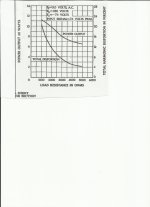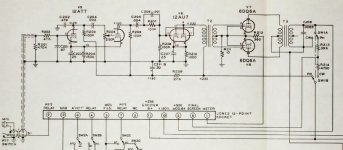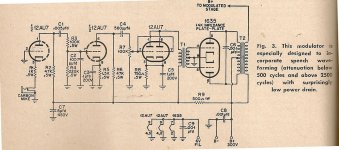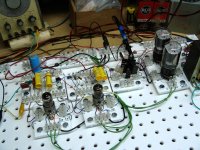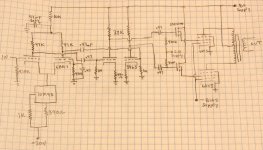I built a 80Wrms with <2% THD without any feedback. This thing is amazing ion terms of power, smoothness and musicality.
I've been using a GU46 in triode mode at 1500V plate and screen.
This voltage is way above the 650V limit stated in the datasheet. Still it works really well, very linear, similar to a huge 300B, but had a couple of flashing issues that destroyed the 1000V coupling cap in G1, at turning on.
So I was thinking I could drive the tube via G2 with some (350V) DC and control the bias current with just a negative DC voltage in G1.
I need someone really knowledgeable in emission tubes to guide through this.
Mainly concerned in stability (plate current), linearity and G2 driving current.
Thanks
I've been using a GU46 in triode mode at 1500V plate and screen.
This voltage is way above the 650V limit stated in the datasheet. Still it works really well, very linear, similar to a huge 300B, but had a couple of flashing issues that destroyed the 1000V coupling cap in G1, at turning on.
So I was thinking I could drive the tube via G2 with some (350V) DC and control the bias current with just a negative DC voltage in G1.
I need someone really knowledgeable in emission tubes to guide through this.
Mainly concerned in stability (plate current), linearity and G2 driving current.
Thanks
Where exactly did you observe the flashings that destroyed the coupling capacitor? Within the tube in question? Well, now you know at least one reason why voltage ratings for tubes as well as for capacitors do exist!
Best regards!
Best regards!
Caipirinha, thanks for your help, it's been quite usefull.
Th cap is adequately chosen for the place and function...
Th cap is adequately chosen for the place and function...
It probably works well 😀. But in triode that would mean limiting the supply to 650V.
That tube developed an arc, sending 1500V into the coupling cap and sending you Back to the Future. That sounds like something Tubelab George would do. That tube might not survive many of those events. Might reward you with bits of glass all over the room. Or a fire.
At 2X data sheet ratings, things often work well for a while. But don’t turn your back on it for an instant. MANY triodes, of all walks of life, have extremely linear characteristics well up into the red plate region. Tempting…..
That tube developed an arc, sending 1500V into the coupling cap and sending you Back to the Future. That sounds like something Tubelab George would do. That tube might not survive many of those events. Might reward you with bits of glass all over the room. Or a fire.
At 2X data sheet ratings, things often work well for a while. But don’t turn your back on it for an instant. MANY triodes, of all walks of life, have extremely linear characteristics well up into the red plate region. Tempting…..
Gerritube, I can publish the schematic but I believe it is not important. The GU46 is connected as triode, G2 to Anode via a 180 Ohm resistor and G3 to Cathode.
1500V in the Anode and G2, Cathode and G3 directly to ground G1 with -250Vdc, signal via G1.
1500V in the Anode and G2, Cathode and G3 directly to ground G1 with -250Vdc, signal via G1.
D% looks good. But without NFB the screen driven connexion will get the same DF as running as pure pentodes.I built a 80Wrms with <2% THD without any feedback.
Usually much less than unity,🙂
Damping factor. Translation: Wont sound anything like a triode.
And require a good 1000 volts of drive - good luck getting THAT at 2% THD.
And require a good 1000 volts of drive - good luck getting THAT at 2% THD.
That's why I chose to go triode, the transformer primary inductance is not high enough for pentode (it is a big transformer)
Well, I might just have to live with it as it is,. As it happened both times with the same tube and was spaced a few months I replaced the output tube, (maybe it had the g2 to close to G1 or heat made G2 sag a little more than normal) and added diodes from G1 to ground, protecting the cap....
Still would love to hear from someone who drove a similar pentode in triode mode via G2.
Well, I might just have to live with it as it is,. As it happened both times with the same tube and was spaced a few months I replaced the output tube, (maybe it had the g2 to close to G1 or heat made G2 sag a little more than normal) and added diodes from G1 to ground, protecting the cap....
Still would love to hear from someone who drove a similar pentode in triode mode via G2.
If you drive g2 instead of g1, it looks more like pentode/tetrode operation than triode. If you then use schade feedback to g1 to try to “generate” triode curves, the g2 drive requirement goes from the ridiculous to the sublime. Any stories you “hear” will not likely have happy endings.
A well designed triode amp will have a Damping Factor of ~3, That means the internal impedance/resistance of the amp is 1/3 of its load.
An Ultra Linear wired amp comes at about One for a DF. No matter whether it is PP or SE. The DF in the UL case depends on the degree of screen NFB.
A pentode amp exhibits very poor DF with numbers like 0.25. Doesn't matter whether the tube is operated as a pentode or screen driven,
it is still a pentode. And measurements prove that. The loudspeaker diaphragm just keeps travailing, no control at all.
But takes only 6-8 db of NFB to make a significant difference tho,🙂
Can you show us a schematic please?🙂Mainly concerned in stability (plate current), linearity and G2 driving current.
I built a 80Wrms with <2% THD without any feedback. This thing is amazing ion terms of power, smoothness and musicality.
I've been using a GU46 in triode mode at 1500V plate and screen.
This voltage is way above the 650V limit stated in the datasheet. Still it works really well, very linear, similar to a huge 300B, but had a couple of flashing issues that destroyed the 1000V coupling cap in G1, at turning on.
So I was thinking I could drive the tube via G2 with some (350V) DC and control the bias current with just a negative DC voltage in G1.
I need someone really knowledgeable in emission tubes to guide through this.
Mainly concerned in stability (plate current), linearity and G2 driving current.
Thanks
A 300b tube has quite high distortion, not very linear. Maybe you meant to say something else?
Below is data showing the high distortion of said tube at different output wattages under listed conditions.
Besides that, the drive voltage required will have somewhat high distortion unless special precautions are taken.
As such, for the driver and output stages, 2nd and 2nd create 4th order, 2nd and 3rd (and 3rd and 2nd) produce 6th order,
and 3rd order and 3rd order produce 9th order harmonics.
Many design using low impedance OPTs for as much 2nd order distortion as possible, for a smoother sound and possibly
larger soundstage.
The RCA Radiotron Designers Handbook also lists at least 5 other distortions besides harmonic distortion. There are also
other forms not listed such as dielectric absorption (DA) distortion etc.
Hope this helps.
pos
Attachments
Driving screen directly and G1 via a resistor can get good results. 807/6L6 120 watts 2% THD. http://amfone.net/Amforum/index.php?topic=44390.0
On a forum where the first watt matters, a zero bias Class B amplifier is not a good choice.👎Driving screen directly and G1 via a resistor can get good results. 807/6L6 120 watts 2% THD. http://amfone.net/Amforum/index.php?topic=44390.0
The Class B amp is well known for 'cross-over' distortion as the signal level is reduced.
Some examples here for the curious & the lurkers.
All well documented in books on electronics, both toobz & SS,🙂
Attachments
Several members including myself explored screen (G2) drive quite some time ago. Several threads were spawned discussing the merits and pitfalls of doing so. There is a possible failure mode in a screen driven amp that blows a lot of parts. A quick search found one of the old threads. Post number 68 in that thread leads to links of many other experiments along these lines. There was considerable screen drive and "dual drive" or "crazy drive" (G2 and G1 drive) experimentation being done at that time. Some searching and link chasing should find most of it.
https://www.diyaudio.com/community/...een-drive-circuits.237808/page-4#post-3583108
https://www.diyaudio.com/community/...een-drive-circuits.237808/page-4#post-3583108
I remembered building a screen driven push pull amp about 20 years ago on a breadboarding system I called the Tubelab. That system is where the Tubelab name came from. The Tubelab breadboarding system went through several revisions but hasn't been used since I left Florida in 2014. I did however find some pictures and the schematic of that breadboarded amp.
The amp used 6AV5 tubes for the output. The 6AV5 is a 6BQ6GA without a plate cap. I got about 80 watts out of this thing, but have not seen my old notebook since I left Florida so I don't have the measured specs. As stated, a screen driven amp has a poor DF, possibly worse than the same tube in pure pentode mode. Play bass heavy music through it with big speakers and it will sound like the kid's boom-boom car down the street......without the license plate rattle. It did make for a screaming guitar amp though.
The amp used 6AV5 tubes for the output. The 6AV5 is a 6BQ6GA without a plate cap. I got about 80 watts out of this thing, but have not seen my old notebook since I left Florida so I don't have the measured specs. As stated, a screen driven amp has a poor DF, possibly worse than the same tube in pure pentode mode. Play bass heavy music through it with big speakers and it will sound like the kid's boom-boom car down the street......without the license plate rattle. It did make for a screaming guitar amp though.
Attachments
Thanks, Tubelab, that is helpfull!
But main turn-off is the impedance issue as I was avoiding going pentode because of that.
Probably stick to triode, it works like a dream
But main turn-off is the impedance issue as I was avoiding going pentode because of that.
Probably stick to triode, it works like a dream
There is another alternative that I developed after wasting too much time with G2 drive and G1+G2 drive. I don't know anything about the GU46, so I don't know if it's suitable, but a technology I call UNSET gets triode curves from a pentode connected tube by driving the cathode and applying local plate to grid feedback directly to G1. G2 gets connected to a suitable fixed voltage screen supply. Amps built with this design do work quite well.
See these threads:
https://www.diyaudio.com/community/threads/unset-is-coming.340856/
https://www.diyaudio.com/community/threads/unset-beta-board-build.376124/
See these threads:
https://www.diyaudio.com/community/threads/unset-is-coming.340856/
https://www.diyaudio.com/community/threads/unset-beta-board-build.376124/
- Home
- Amplifiers
- Tubes / Valves
- driving emission tubes by the G2
